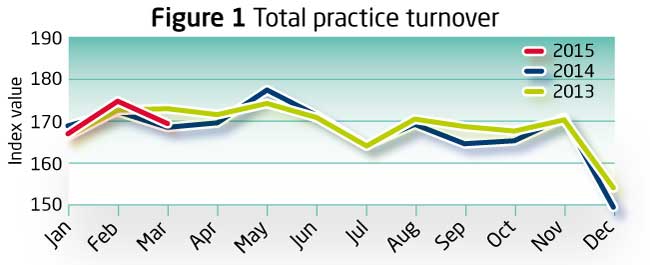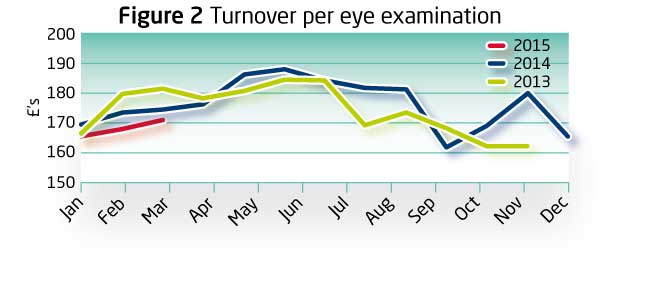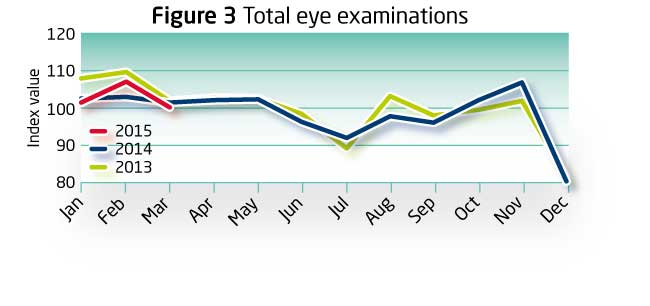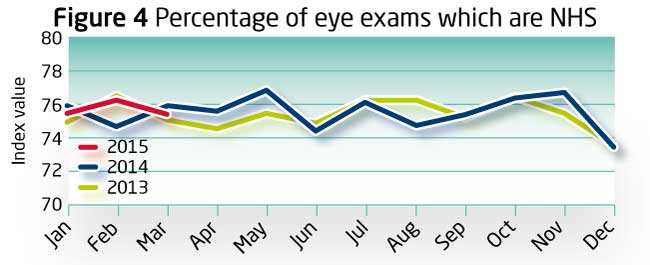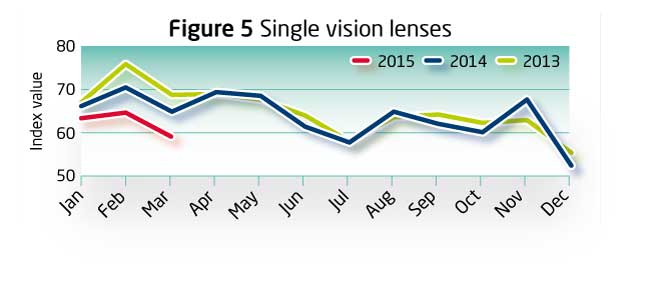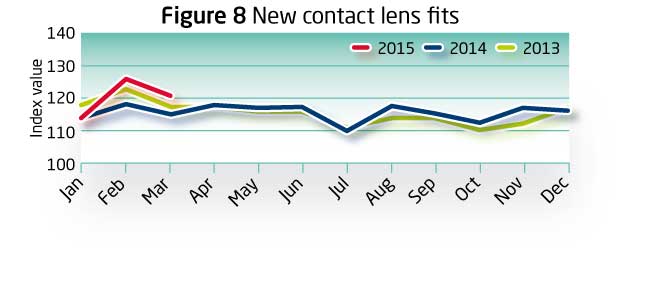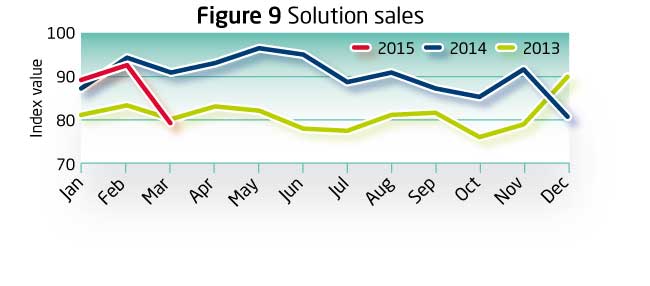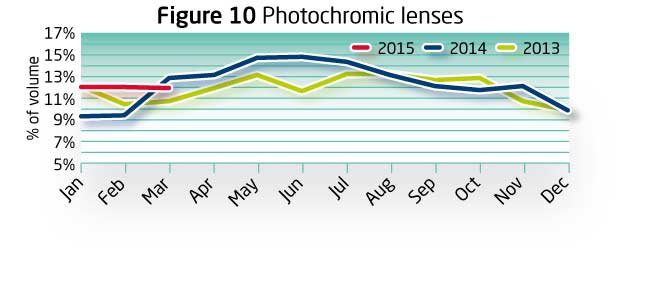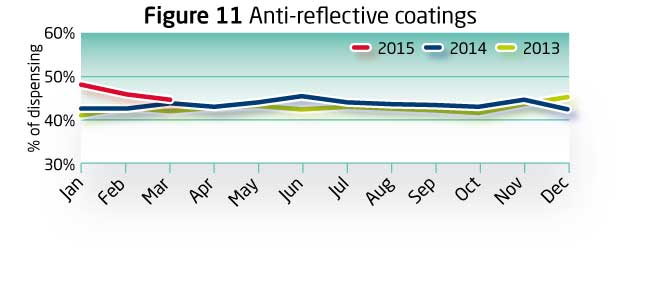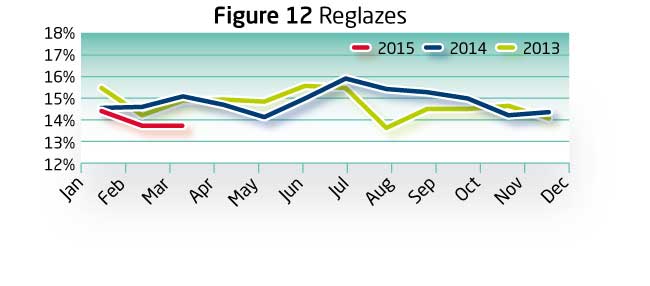 At the end of the first quarter we are taking a look at how our key performance indicators compare with the same quarter of the previous two years, as well as how they have performed against last month and March 2014. After positive results in February, the data for March is not so encouraging with all key performance indicators, apart from turnover per eye examination, at lower levels than last month. Total turnover held up this month compared with March last year but with the exception of sales of progressive lenses and new contact lens fits our other indicators failed to meet the Index figures reported in March 2014.
At the end of the first quarter we are taking a look at how our key performance indicators compare with the same quarter of the previous two years, as well as how they have performed against last month and March 2014. After positive results in February, the data for March is not so encouraging with all key performance indicators, apart from turnover per eye examination, at lower levels than last month. Total turnover held up this month compared with March last year but with the exception of sales of progressive lenses and new contact lens fits our other indicators failed to meet the Index figures reported in March 2014.
Optician Index is based around the idea of benchmarking. Benchmarking has become a sophisticated management tool providing performance indicator comparisons which assist business owners and managers in their strategic and tactical business planning. The figures can be used for more than just looking at market trends. By comparing the sample data with your own practice performance, you can identify problem areas and take the necessary steps to correct and fine tune business activity. Without benchmarking it is only possible to look internally at historical results and therefore management only has a subjective view of what customers want and what competitors are achieving. One of the benefits available to Optician Index panel members is a customised report which tracks their business performance against the sample of independent opticians, and enables them to see if they are under- or over-performing.
The total practice turnover chart (Figure 1) shows the positive figure in February this year has resulted in a first quarter which is marginally positive with just a 0.2 per cent increase over the same period last year.
Total turnover this month shows a decrease of 3 per cent to 169 Index points from February, which is practically the same as March last year. This is four Index points below March 2013 and the annual growth, which compares the totals for the last 12 months with the preceding 12 months, is fractionally negative. In broad terms turnover has been flat, over the past two years, for our sample of independent opticians.
Turnover per eye examination (Figure 2) shows a steady increase this quarter with higher values reported each month, but the average monthly figure is just over £4 down from the first quarter last year. March produced a value of £171.20, which is a £3 increase on last month but £3 lower than March last year.
Total eye examinations (Figure 3) are also broadly flat over the last two years, reducing in March this year to 100 Index points, 6 per cent lower than February and slightly lower than March last year.
The net result for the first quarter is a 0.3 per cent increase with the same period in 2014. The percentage of eye examinations which are NHS (Figure 4) this quarter is slightly higher than the first quarters of the two previous years. In March, the value decreased by almost 1 percentage point to 75 per cent from February, just below the percentage in March 2014.
Dispensing and lenses
The sample average total dispensing has decreased this month to 89 Index points, 6 per cent lower than last month and 4 per cent lower than March 2014. The sample average dispensing rate, which is calculated by dividing the total volume of spectacles dispensed by the total number of eye examinations carried out, has gone up this month by just 1 percentage point to 63 per cent which is 1 percentage point lower than March last year.
The sales volume of single vision lenses (Figure 5) failed to meet the peak Index value of last February and fell by 8 per cent this month to an Index figure of 59 which is 9 per cent lower than March last year.
Bi/trifocal lenses (Figure 6) saw the volume of sales reported for the first quarter below those of the two previous years and have seen a significant 12 per cent decrease, from February of this year, to 50 Index points.
Progressive lens (Figure 7) sales volume has fallen this month by 3 per cent on February to an Index figure of 209 just above that recorded in March last year. The net result for the first quarter of 2015 is positive over the same period in the previous two years and annual growth is also positive at 2 per cent.
New contact lens fits (Figure 8) are higher this first quarter than over the previous two years. The Index value for March reduced by 4 per cent to 121 Index points from February which is 5 per cent higher than the Index value last March.
Contact lens solution sales (Figure 9) for March reduced by 14 per cent to 80 Index points from February this year, and this is 12 per cent lower than March last year. The Index values for this measure, over the first quarter of 2015, are lower than last year but exceed those of 2013.
The percentage of spectacles dispensed with photochromic lenses (Figure 10) has not changed this month at 12 per cent but this is 1 percentage point lower than March last year. The percentage for this first quarter is higher than the percentage in the same quarters for the previous two years.
Anti-reflective coatings (Figure 11) show a higher percentage of lenses treated during this first quarter of 2015 compared with the same quarter in 2014 and 2013. March this year is 1 percentage point lower than February at 45 per cent of all spectacles dispensed, but this 1 percentage point higher than March last year.
Reglazes (Figure 12) changes little month by month, the lowest figure since January 2013 being 13.7 per cent and the highest 15.9 per cent of spectacle sales. Through this first quarter the average percentage has dropped by almost 1 percentage point from below 15 per cent in 2014 to just below 14 per cent in 2015.
Summary
- Total turnover for March falls by 3 per cent to 169 Index points from February but a quarterly comparison with the same period last year is positive by 0.2 per cent
- Total number of eye examinations for March falls by 6 per cent to 100 Index points from February, but quarterly comparison with last year is also positive by 0.3 per cent. Average monthly turnover per eye examination for the first quarter is £168.35, £4 lower than the first quarter of 2014
- Sample average dispensing is 4 per cent lower than March 2014, at 89 Index points
- Contact lens new fits are 5 per cent higher than March last year, at 121 Index points
All figures are adjusted to a 25-working day month. In March 2015 there were 26 working days.

